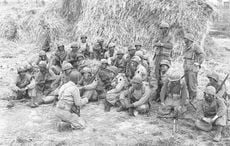Two coffins of bones, just some of the remains of thousands of Irish Great Hunger victims who were buried in a mass grave, were reinterred in 2014, in the Moravian Cemetery.
At the receiving tomb in Moravian Cemetery on Staten Island, NY there are two caskets of bones, the remains of some of the tragic Irish buried in a mass grave on the site of what is now the St. George Courthouse. The remains will be finally laid to rest in the spring of 2014.
Side by side in the marble receiving tomb lie two caskets. One, white and decorated with angels, for those of the children’s remains, and one for adults. However, sadly, it is unknown how many people’s remains are in the coffins.
Lynn Rogers, the Executive Director of the Friends of the Abandoned Cemeteries, who is heading up this reinterment, explained that when construction began on the new court building in the early 2000s, “the bulldozers drove through some of the bodies were just cut in two."
Between 1799 and 1858, Staten Island was home to the Marine Hospital Quarantine Station, where tens of thousands of immigrants, largely from Ireland, were sent to recover if New York medical inspectors found them suffering from infectious diseases. Between 1845 and 1852, as the Great Hunger ravaged the Irish nation, many of those arriving in New York were Irish.
Rogers said, “It was a ghastly end for so many of these people who had left Ireland in hopes of a new life in America.
“Their fate was tragic, but now, more than a century and a half later, they will receive the recognition and benediction they never received in life.”
Many of those quarantined died in the Marine Hospital, located in the St. George neighborhood of Staten Island, and were buried en masse in cemeteries operated by the Quarantine Station.
One New York newspaper reported in April 1851, “The number of poor people from Ireland who are wandering through the streets of Staten Island in a starving condition is dreadful.”
PHOTOS - Remains of victims of Ireland's Great Hunger at Moravian Cemetery, Staten Island
They died in the streets or at the Marine Hospital. Rogers explained, “There were no records, no death certificates. In many cases, people were dying before they could get them up the hill to bury them. They were being buried in mass graves as they died.”
During construction of the St. George Court facilities, a team of professional archaeologists exhumed the remains from these mass graves. DNA testing revealed that all exhumed bodies were of Celtic origin.
There are thousands of remains beneath modern-day Staten Island, buried in haste to avoid the spread of disease at the time.
Rogers told IrishCentral in 2013, “There’s two cemeteries. There’s the one that became the parking lot and there’s another one that today is a huge golf course, and that’s where they buried the majority of them. There absolutely are thousands of bodies there.
“The reason they made the cemetery into a golf course in the 1920s /1930s is because there are just too many remains in there. There must be tens of thousands.”
The reinterment of these remains has touched many Irish and Irish Americans searching for their ancestors, who they believe traveled to New York. Often, their research comes to a dead end when they find no record of arrival or a death certificate. Thousands simply disappeared.
Richard L Simpson, a promoter of Staten Island history who visited the coffins said, “It struck me when we were looking at these coffins, 'These could be members of my family and I’d never know.'”
Rogers said the interest in the reinterment of the bones has been astounding. Many people are making the journey from as far as Chicago to pay their respects on April 27.
She added, “Many Irish immigrants, whose only reason for being on Staten Island was because of the quarantine decided to stay and make their new life here. Today, they are 6th and 7th generation Staten Islanders. It would be so fitting if some of the heirs of those first immigrants were to join us on the 27th.”
The Friends of Abandoned Cemeteries will oversee reburial of those remains in a recreated cemetery on the grounds of the new St. George courthouse. Participating at the graveside reinterment will be Monsignor James Dorney, Assemblyman Michael Cusick who is also president of the American Irish Legislators Society of New York State, the Ancient Order of Hibernians, the Staten Island Pipes and Drums, SIOutLOUD and tenor Andy Cooney.
The Friends of Abandoned Cemeteries is also producing a commemorative booklet and is seeking memorial ads. For more information contact SICemetery@gmail.com or call 917-545-3309.
PHOTOS - Remains of victims of Ireland's Great Hunger at Moravian Cemetery, Staten Island
* Originally published in 2014.




Comments